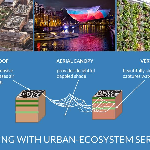
Cooling with Urban-Ecosystem Services by Biomimicry NE
 Jennifer Lawrence Feb 3, 2015 11:18 |
Dear Biomimicry NE:
Thank you for this inspired proposal. It is very creative. We are especially happy that a local organization was able to participate in this international contest.
A few questions for you to consider before the due date on Friday (February 6th):
1) It would be helpful to us if you could more clearly outline the costs. I do not know how much these aerial nets cost, for example. Can you give us a general idea on what this has cost elsewhere?
2) What happens in inclement weather? Again, I am thinking of the aerial nets. Do they get removed during winter/extreme wind events? Does snow fall through the nets? What have other locations done to address this concern?
3) We really appreciate the public process you have written into this proposal. This is a key goal of our planning processes, and we are happy that you will be crowdsourcing location ideas. That said, given your expertise in the Greater Boston region, where specifically in Cambridge can you see a few of these projects working?
Thank you again!
Sincerely,
Jen
|
 Tim Mcgee Feb 3, 2015 02:10 | Proposal contributor
Thanks Jen!
We will address the questions of costs, location and duration in the proposal. Informally, the first net suspended in Portugal (which is a permanent installation) was 1.6 million dollars. The location, technology, and type of net will impact cost, but as we can now use existing structures for hanging a net the cost has decreased in that regard. Weather is always a consideration, and the nets can be designed to be permanent installations. Lastly the places that might benefit most from the nets given the local environment include Central Square area, down mass ave. As well as around Alewife transportation area. These places are highly urban, with broad paved spaces that also see a lot of public interaction and could benefit from the aerial canopy.
Best,
Tim
|
 Climate Colab Feb 18, 2015 12:18 |
Congratulations on making it to the Semi-Finals for the Urban Heat Island Effect contest. Please take into consideration the comments left by the judges and do please incorporate that feedback into your final proposal.
In addition to the questions below, can you also give some insight into maintenance?
We look forward to seeing your ideas finalized in the next iteration!
|
 Jennifer Lawrence Feb 18, 2015 11:15 |
Dear Biomimicry:
The CoLab had a typo in their previous message to you. The proposal revision period closes on March 1st, NOT the 31st. Below are your proposal's comments from the judging team.
Thank you for participating!
Judge 1: This is an interesting proposal. Perhaps clarifying why Zebra and not entirely a white roof. Also the aesthetic of the aerial canopies should be suggested. Maybe a detailed proposal for a case study can support this project to show it's deployment and scaling-up potentials.
Judge 2: Do Zebra Roofs work similar to blue roofs in using physical barriers on the roof to slow water runoff? Considering the stripes are painted on, it doesn't seem like they would actually slow down runoff. Please elaborate. Green walls are generally maintenance intensive especially soil based, so I would move away from incorporating too many green walls. Green facades, using vines on trellising, are lower maintenance and less expensive. Could you incorporate some green facade trellising into the aerial canopies?
|
 Tim Mcgee Feb 19, 2015 04:48 | Proposal contributor
Great questions and excited to be considered as part of the semi-finalists.
We are excited to dive in to respond to these questions, but also quickly wanted to respond to the Zebra stripes:
On the zebra itself it has been found that the alternating bright white, and dark black color pattern creates an increased airflow with turbulence over the surface. This turbulent airflow increases the mixing of air between the surface of the zebra and the air itself - this in turn increases evaporation, and thus increases cooling of the zebra.
Similarly, forests create turbulent air-flow that increases air mixing, to increase evaporation... so we are functionally using stripes to create turbulent flow that would help mix air from the surface of roofs. I think in part combining this with blue and green roof systems might have further benefit, and will investigate this as part of our research.
Excited to dive in and clarify these details.
|
 Hanaa Rohman Feb 23, 2015 11:23 |
Hi there,
Thanks for the clarification about the zebra stripes, that sounds very cool! Just a reminder: be sure to update your proposal with these details as well.
Best,
Hanaa
|
 Michael Hayes Feb 28, 2015 04:59 |
Dear Biomimicry,
It may be worth investigating how to waterproof bacterial fabric for this application.
You may have run across this:
http://www.ted.com/talks/suzanne_lee_grow_your_own_clothes?language=en
Designer Suzanne Lee shares her experiments in growing a kombucha-based material that can be used like fabric or vegetable leather to make clothing.
I've been looking into different non-GMO options for waterproofing this type of fabric as I could use vast amounts of fabric in off-shore applications.
If your group has any interest in this path, please let me know.
Michael
|
 Michael Hayes Feb 28, 2015 05:48 |
Also,
1) I see your canopy designs as great platforms for fire hydrant based cold water misting operations. Installing small diameter cold water lines and misting nozzles, much like is used in greenhouses, would provide the canopies with a wide area cooling effect.
2) If such a cold water misting network is incorporated into the canopy fabric, rapid changes in water pressure may cause the canopy to move in a predicable way. Thus, this method may lead to a means for moving large volumes of air mass within areas like urban canyons.
I'm proposing the creation of a large ice sheet on Fresh Pond to create a cooling advective current. I would like to increase the air mass flow rate over the ice and using the misting canopy and or mechanized velarium concepts is high on the list of options.
Best wishes,
Michael
|
 Tim Mcgee Feb 28, 2015 05:47 | Proposal contributor
Hi Michael,
Materials, fiber, textile, and fabric development are all long-term research interests of mine as well, and while not part of our proposal for UHI specifically could continue to advance what is possible. I would be delighted to chat more with you about these ideas, and projects regarding bacterial cellulose, or other bio-inspired materials.
It is also great to see how you tie the different proposals together - we are excited to continue to grow and evolve the design with the community as it could take many forms.
Cheers,
Tim
|
 Laur Hesse Fisher Mar 4, 2015 09:20 |
Dear proposal authors:
The Finalist selection phase has been extended so Judges could finalize their comments. The Fellow team will be in touch with more details as they arise.
Thank you for your patience and understanding.
~~
Laur
Climate CoLab Project Manager
|
 Climate Colab Mar 6, 2015 12:58 |
Judging comments:
Nice job combining a number of measures into one project that could have a natural relationship. There is no silver bullet, so we will need to integrate these types of technologies to make a significant impact.
I see all endeavors as feasible, but a structural engineer will need to be involved to approve any and all anchoring mechanisms for both canopy and green facade. I do not approve the green wall proposal which is a soil-based vertical green wall. I do approve a green facade which is a trellis-based vertical green wall which trains vines that are growing up out of the ground.
Green facades are significantly less maintenance, but it will be important to ensure that the vines don't grow into the siding or windows or flashing of a building. It will therefore be important to secure funding to prune the vines, which will probably include renting a piece of lifting equipment.
I wish I knew more about the effectiveness of the Zebra stripes, but they sound and look cool. Is there a case study you could site?
Your graphics are strong.
|
 Michael Hayes Mar 13, 2015 07:18 |
Hi Tim,
I just un-earthed another biofilm which may be of interest to your group relative to this challenge.
Biomaterial film for soluble organic sorption and anti-microbial activity in water environment
http://www.sciencedirect.com/science/article/pii/S0960852412001903
A rain resistant anti-microbial canopy can have a number of interesting applications especially in areas such as large refuge camps which always under threat of both air-born and water born pathogens.
Obviously, Cambridge is not a refugee camp (well maybe for PhDs), yet demonstrating such a canopy through this challenge could help spread the word about the synergies.
Best wishes,
Michael
|
 Jan Kunnas Mar 20, 2015 05:27 |
Hi, linked this interesting proposal to mine as it produce the bio fertilizers needed for your vertical walls. https://www.climatecolab.org/web/guest/plans/-/plans/contestId/1301402/planId/1314801
|